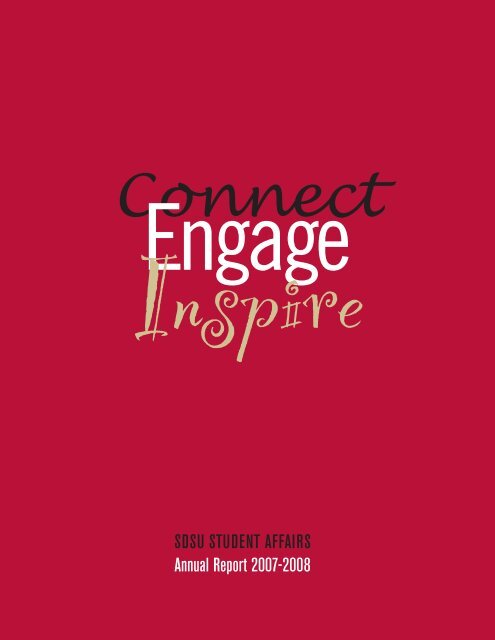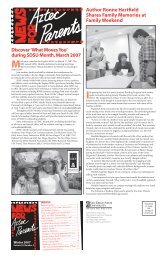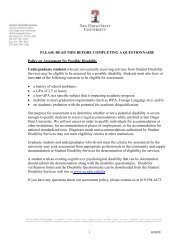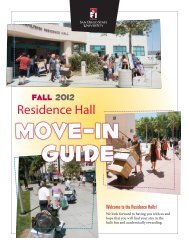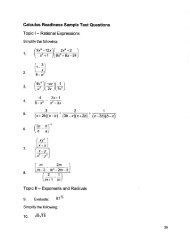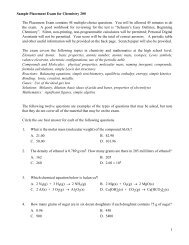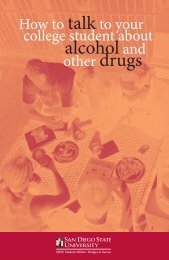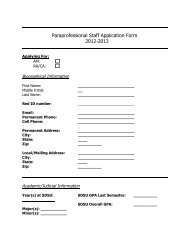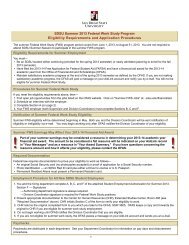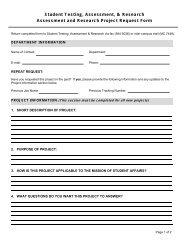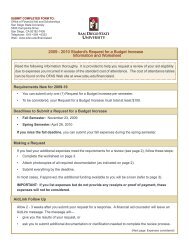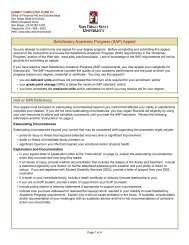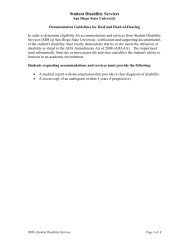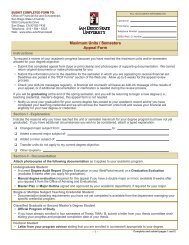PDF file - SDSU Student Affairs
PDF file - SDSU Student Affairs
PDF file - SDSU Student Affairs
You also want an ePaper? Increase the reach of your titles
YUMPU automatically turns print PDFs into web optimized ePapers that Google loves.
ConnectEngageInspire<strong>SDSU</strong> STUDENT AFFAIRSAnnual Report 2007-2008
<strong>SDSU</strong> STUDENT AFFAIRSAnnual Report 2007-2008ConnectEngageInspireMessage from the Vice President ........2<strong>Student</strong> <strong>Affairs</strong> Mission Statementand Vision Statement...........................3Access ....................................................4Academic Enrichment ..........................6<strong>Student</strong> Life and Leadership................8Positive Choices..................................10Collaborations andPartnerships .......................................12Honors, Awards and Recognitions ....14In Memoriam......................................16<strong>Student</strong> <strong>Affairs</strong> Offices.......................171
WelcomemissionvisionDr. James R. KitchenVice President for<strong>Student</strong> <strong>Affairs</strong>Connect. Engage. Inspire. ese arethe goals of every <strong>Student</strong> <strong>Affairs</strong> staffmember. From an EOP counselor to a <strong>Student</strong>Health Services practitioner; from the<strong>Student</strong> Testing front office worker, to theimaginative coordinators in the Office ofNew <strong>Student</strong> and Parent Programs – everyone of us strives to connect with students,to engage them in our programs and services,and to inspire them to achieve theirdreams of a successful college education.Every program and service in the Divisionof <strong>Student</strong> <strong>Affairs</strong> translates to retentionand success. Inside this annual reportyou’ll find many instances of the successeswe had during the 2007-2008 academicyear.Prior to the beginning of the year, we outlinedseveral goals that we wanted toachieve, and we’ve made great progress.Key goals included:• Continue to expand living and learningcommunities. Our goal is to go from350 beds in 2006-2007, to 625 beds in2007-2008, to 800 beds in 2008-2009.• Continue to increase the participationrate of transfer students attending newstudent orientation.• Continue to target “at-risk” students –our most vulnerable students on campus.It is critical that these students (20percent of the student population) connectto campus resources, programs andservices, such as EOP, Bounce Back,Freshman Success Programs, Living andLearning Communities and CompactScholars, all of which support their academiclearning.• Continue to work with the Associated<strong>Student</strong>s and the campus community onthe creation of the <strong>SDSU</strong> LeadershipCenter.You’ll see from the 2008 highlights thatfollow that the Division of <strong>Student</strong> <strong>Affairs</strong>has succeeded in fostering innovative programsand services that help <strong>SDSU</strong> studentsconnect, engage and inspire. It is ourbelief that every student should haveaccess to a university education. In order todo so, we strive to provide access to financialresources, supportive student services,and diverse learning opportunities.Sincerely,Mission Statemente Division of <strong>Student</strong> <strong>Affairs</strong> is astudent-centered partner in the <strong>SDSU</strong>learning community. Education isenhanced, both inside and outside of theclassroom, through quality supportservices and programs that advancestudent learning and development.e Division contributes to academic andpersonal success, encourages independentcivic responsibility, and promotes thewelfare of all students. <strong>Student</strong> <strong>Affairs</strong>helps connect students to the Universityand to their future, building alliances thatfoster retention and loyalty beyondgraduation.Vision Statemente Division of <strong>Student</strong> <strong>Affairs</strong> plays a vital role in the personal growth, wellness, intellectualdevelopment, academic achievement and career success of each individual student by:• Fostering a campus culture that encourages each student to articulate his or herown goals for success;• Enhancing the learning environment and expanding learning opportunities for allstudents inside and outside the classroom;• Promoting a campus climate that values, accepts and learns from our rich diversity;• Developing leaders who believe in and lead others toward supporting civility,mutual respect and diversity in our society and workplaces;• Expanding the opportunities for students to participate in local, regional andinternational experiences;• Building and expanding the human, technological and physical resources thatsupport growth and development.Dr. James R. Kitchen2 3
Accessspotlight onWellness<strong>Student</strong> <strong>Affairs</strong> provides programs and services that offerour most vulnerable students access to a quality education.<strong>Student</strong>s at risk don’t need a hand out, but a hand up tobecome successful college graduates. Many <strong>Student</strong> <strong>Affairs</strong>departments serve as that helping hand.College Access ProgramLast year, <strong>Student</strong> <strong>Affairs</strong> launched the<strong>SDSU</strong> College Access Program, anearly outreach college-preparation programtargeted to low-income, first generationeighth-grade students in the San DiegoUnified School District. By spring 2008,the initial program design was completedand staff began sessions at the four partnermiddle schools and a test partner K-6school. <strong>SDSU</strong> staff travel to each school atleast once weekly to teach one session of acomprehensive curriculum that includesinformation on the value of higher education,career planning, high school courseworkrequired for CSU or UC admission,the college application and admissionsprocess, and financial aid and scholarships.Guardian Scholars ProgramBill Boyd, former Senior Associate VicePresident for <strong>Student</strong> <strong>Affairs</strong>, headed thelaunch and development of the <strong>SDSU</strong>Guardian Scholars Program, a comprehensiveprogram of support servicesdesigned to assist former foster youth asthey pursue their first degree at <strong>SDSU</strong>.Boyd appointed the Directors of EOP andthe Office of Financial Aid and Scholarships(OFAS) to co-chair the program developmentcommittee, composed of select stafffrom the offices of EOP, OFAS, and the CollegeAccess Program. e first cohort ofGuardian Scholars began at <strong>SDSU</strong> in fall2007, and fall 2008 will see the continuationof the prior year’s class as well as theentry of the second cohort of Scholars., , ; Guardian Scholars Programparticipants. e Accommodated Testingcenter, part of <strong>Student</strong> Disability Services.Removing Barriers to Education<strong>Student</strong> Disability Services (SDS)served a record 1,219 students with verifieddisabilities in spring 2008, supportingtheir academic success by removing barriersto education. SDS continues to providelegal accommodations such as sign languageinterpreters, captioning, test accommodations,and classroom materialsproduced in alternate format (e.g., e-text,Braille) to assure that students with disabilitiesare graded on their performancerather than on their disabilities. Owing tothe larger capacity offered by the CalpulliCenter location, SDS was able to monitormore than 4,150 accommodated tests thispast year, an increase of nearly 20 percentover the prior year.Online Schlolarship ApplicationIn 2007-2008, the Office of FinancialAid and Scholarships developed andimplemented a secure online scholarshipapplication that allows <strong>SDSU</strong> students tocomplete their scholarship applications,including essays, using a Web-based system.Additionally, OFAS developed andimplemented a complementary onlinereview and selection process that has eliminatedthe manual, paper-intensive processof the past.Enhancing Academic Skillse Office of Educational OpportunityPrograms (EOP) admitted morethan 1,000 low-income, educationally disadvantagedstudents in 2008. In terms ofstudents served, the 2007 Summer Bridgewas the most successful in the program’s23-year history, serving 33 percent morestudents than the prior year. Based onSummer Bridge’s proven success atenhancing the academic skills of incomingfreshmen, Summer Transfer Bridge wasdeveloped to provide the same benefit forincoming transfer students, and the programwas offered for the first time in summer2008. EOP’s Center for AcademicAchievement and Training (CAAT) pro-vided 7,067 tutoring appointments duringthe 2007-2008 school year, an increase of42 percent from the previous year.e EOP <strong>Student</strong> Volunteer Programwas developed and implemented. Drawingon a previously untapped volunteer base,EOP has trained more than 100 studentvolunteers to assist at EOP events andwith school tours.Outreach to Returning <strong>Student</strong>sUnderstanding that the sophomore year isthe “critical” year for many students, theResidential Education Office placedspecial emphasis on outreach to returningstudents. rough its efforts at targetingthe freshman class of 2007, the number ofreturning students committed to living inon-campus residence halls increased from12 to 25 percent.International <strong>Student</strong> Recruitmente International <strong>Student</strong> Centerreceived funding to launch an internationalstudent recruitment program. Res-ults forthe fall 2008 admissions cycle show internationalapplications increased 28 percentfor undergraduates and 16 percent forgraduates compared to the prior year.Placement for <strong>Student</strong>s with Disabilitiese WorkAbility IV Program is anongoing interagency collaboration between<strong>Student</strong> Disability Services, Career Services,and the California State Departmentof Rehabilitation (DoR). Embedded inSDS, the program strives to place <strong>SDSU</strong>students with disabilities in career positionsrelated to their major. In comparisonwith the eight other four-year college campusesin California that participate in theWAIV Program, <strong>SDSU</strong>’s program ranksnumber one in all but one category (and inthat category, <strong>SDSU</strong> ranks number two).Truly one of the university’s success stories,the program added more staff supportthis year and the DoR counselor on-siterepresentation was significantly increasedto match demand.All students must have access to quality health care andwellness programs to achieve their best.High Quality Medical Care<strong>Student</strong>s receiving care at <strong>Student</strong> HealthServices incur little to no out-of-pocketexpenses for high quality medical care.The department also benefits through itsdesignation as a provider of clinical familyplanning services for the State of California’sFamily PACT Program. This arrangementcan generate significant revenuesfor our facility, allowing us to maintainand even expand services during times offiscal austerity.Dentistry and Optometry Clinics<strong>Student</strong> Health Services developed a significantlyenhanced dentistry and optometryclinics for implementation in fall2008. The advanced clinics will provideimproved overall healthcare services tothe <strong>SDSU</strong> student body.“Say Boo to the Flu”<strong>Student</strong> Health Services’ “Say Boo to theFlu” campaign immunized hundreds ofstudents, staff, and faculty againstinfluenza. Just as critically, <strong>Student</strong>Health Services did an excellent job ofmaking timely notifications to the campuscommunity during a year beset with anunusual number of infectious diseaseincidents among students and instructors.Digital X-ray equipment. Fully-equippedurgent-care facilities. State-of-the-art optometricequipment. Faculty, staff and studentshave access to on-campus flu shots.4 5
Academic Enrichmente primary goal of <strong>Student</strong> <strong>Affairs</strong> is to support the academicmission of the university. Following are just a few examplesfrom the 2007-2008 academic year that enriched academics:New Living Learning Communitiese Residential Education Office significantlyincreased the Living LearningCommunities (LLCs). In 2006, only 300students resided in learning communities.e spring 2008 recruitment campaignsecured more than 1,100 incoming studentsfor the fall 2008 freshman class. ResidentialLearning Community students areretained at higher rates than non-LLC students.New options this year included anemerging leaders program floor; a businessmajor floor; health and the healing professions;women in science and engineering;physical fitness; the Toltec House for undeclaredmajors; an honors floor; and more.Retention(Fr to Soph)GPAOn ProbationNon Resident 70.2% 2.36 30.2%Resident – Non- 83.0% 2.79 12.8%LLC Residents 85.9% 2.86 12.5%In addition to the residential learning communities,Residential Education facilitatedacademic success through its STAR Centeracademic resource labs, the Faculty-in-Residenceprogram, and an increase in thestaff-to-student ratio.Academic Success for <strong>Student</strong> Athletes<strong>Student</strong> Athlete Academic SupportServices (SAASS), made strides towardimproved academic success for studentathletes.e 2006-2007 APR data showsthat 13 of 18 teams improved their multiyearAPR score. e student-athlete GraduationSuccess Rate (GSR) is 75 percent andthe graduation rate of those student-athleteswho exhaust their eligibility at <strong>SDSU</strong>is 84 percent. ere are four teams with aGSR above 90 percent:| | | 50% | | | | 100%- women’s soccer: 90%- men’s golf: 91%- volleyball: 92%- women’s tennis: 100%e learning-centered university is alsosupported by SAASS and is staffed withacademic advisors, a learning specialist, anadmissions/housing coordinator, 15 parttimementors and a variety of subjecttutors. SAASS aims to teach student-athletesto be self-advocates and independentlearners.Setting the Stage Before Classes Begine first connections set the stage forincoming students. With that in mind, <strong>Student</strong><strong>Affairs</strong> strives to interact with allincoming students before they ever beginclasses. One very successful pre-enrollmentevent, New <strong>Student</strong> and FamilyConvocation, had the highest attendanceto date, with more than 8,500 newstudents and family members in attendance.e second annual Transfer <strong>Student</strong>and Family Reception drewrecord numbers with more than 1,400 studentsand family members in attendance.Building Academic Integritye Center for <strong>Student</strong> Rights &Responsibilities’ MITT (Multi IntegrityTeaching Tool) computer based interventionwas assigned in cases of academic dishonestyto build academic integrity andstrategies for academic achievement. Inaddition, the MITT was administered tostudents not cited for academic dishonestyin order to assess student awareness ofthose issues. Follow up showed that actuallytaking the MITT enhanced awarenessof academic dishonesty issues, thus validatingthe effectiveness of this educationalsanction.Minor in Leadership Development<strong>Student</strong> <strong>Affairs</strong>, in conjunction with theCollege of Education, created and receivedapprovals for a Minor in Leadership Developmentthat was implemented in fall 2008.Masters of Artse Masters of Arts; PostsecondaryEducational Leadership with a specializationin <strong>Student</strong> <strong>Affairs</strong>, enrolled morethan 50 students in the 2007-2008 academicyear and continues to be a popularprogram. We see this as the ultimate formof collaboration between <strong>Student</strong> <strong>Affairs</strong>and the College of Education.Relationships with Ethnic StudiesDepartmentse office of Intercultural Relations/Cross Cultural Center continues todevelop and strengthen relationships withall the ethnic studies departmentsthroughout campus. ey worked withCareer Services on developing a programgeared toward educating minority studentson job training preparation; and collaboratedwith EOP on the first annual <strong>SDSU</strong>-Diversity Conference.spotlight on& International Coffee Hour is a funweekly event at the International <strong>Student</strong>Center.GlobalEducationEnhancing Academic StandingThe International <strong>Student</strong> Center (ISC) continuesto grow <strong>SDSU</strong>’s international studentpopulation while simultaneously enhancingthe university’s academic standing. The ISCboasted <strong>SDSU</strong>’s leading cohort in academicperformance this past year. In 2007-2008the ISC hosted more than 650 nonimmigrantundergraduate students earning an average3.28 GPA, and more than 950 nonimmigrantgraduate students, including 60 doctoralcandidates, earning an average 3.47 GPA.Tracking Participation, Effectiveness,Persistence and Success<strong>Student</strong> Testing, Assessment and Research(STAR) developed and implemented a pilotprogram to explore the impact of time limitson performance of English Language Learnerson the WPA, now that a reading selectionhas been added. The office developed cohortdatabases, which can be used to track firsttimefreshmen in terms of programmatic participation,program effectiveness, academicpersistence and successRecord 1,600 Study Abroad <strong>Student</strong>sThe International <strong>Student</strong> Center was instrumentalin increasing <strong>SDSU</strong> study abroad numbersto a record 1,600 students, bringing<strong>SDSU</strong> to the No. 2-ranked position nationallywithin its Carnegie classification. In supportof study abroad, students voted this pastMarch for an increase in the <strong>Student</strong> ActivityFee, 25 percent of which goes to studyabroad scholarships. This is expected togenerate approximately $300,000 annually.e eastside Residential Community. eSTAR CENTER in Maya Hall. New <strong>Student</strong>and Family Convocation. <strong>Student</strong>s meet theircollege deans at the Transfer <strong>Student</strong> and FamilyReception.6 7
<strong>Student</strong> Life & Leadershipspotlight onDiversityWhen asked what they remember most about their collegeexperiences, active alumni cite their involvement and theconnections they made as students. Research supports this:students who are engaged with the university outside theclassroom are more likely to persevere to graduation. Civicengagement, volunteering and student activities play crucialroles in connecting students.Community Engagemente First Annual Community ServiceGala hosted 45 student organizations andcommunity partners, which recognizedtheir community engagement contributions.Community Service<strong>Student</strong>s and staff were involved in manycommunity service efforts throughout thedivision and the university. Just a fewexamples include:• e Homecoming King and Queen-sponsoredUnder One Roof Campaign,which raised more $1,700 for a singlehousehold in New Orleans that had beendevastated by Hurricane Katrina.• 854 students enrolled in in-class servicelearning courses.• <strong>SDSU</strong> had the largest representation atthe Martin Luther King Jr. Parade.• e Civic Learning and CommunityEngagement program hadapproximately 1,400 students participatein community engagement activitiesfor almost 5,000 hours.On behalf of <strong>SDSU</strong>, the programreceived the American Red CrossPurpose Award, the highest regionalhonor the organization bestows to topblood drive sponsors. <strong>SDSU</strong> placed firstamong 20 universities in the region. e458 units or blood donated to the AmericanRed Cross by the <strong>SDSU</strong> communitycould make a difference in the lives ofnearly 1,400 patients.• <strong>Student</strong> Athlete Academic SupportServices sponsored blood drives,YMCA Adopt-a-Family, Junior Seau’sShop with a Jock, MS and cancer walks,Community Options Croquet Safari,reading with schoolchildren, mentoring,Big Brothers and Sisters, among others.• <strong>Student</strong>s from the Residence Halls, Fraternityand Sorority Life, <strong>Student</strong> AthleteAcademic Support Services, <strong>Student</strong>Activities and Campus Life and EOP volunteeredto help displaced residentsfrom the October 2007 fires thatraged throughout San Diego county.• e Intercultural Ambassadors Program,a collaborative effort of the ISCand the International Studies EducationProject of San Diego, is a communityservice initiative designed to promotegreater intercultural awarenessby sending <strong>SDSU</strong> international studentsto visit San Diego public schools.Survey Highlightse <strong>Student</strong> Organization Survey, completedby 57 student organization presidents,include the following highlights: 95percent found what they were looking foron the <strong>Student</strong> Activities and CampusLife Web site; students attend campusevents because friends are going andtopics relate to career goals and interests;students are proud of community serviceprojects; and they enjoy networking with<strong>SDSU</strong> alumni members.@State Online <strong>Student</strong> NewsletterCommunications Services producesthe monthly online newsletter for students,@State, which has seen a progressiveincrease in readership over the years.ere has been a continuous increase inopt-in subscriptions from <strong>SDSU</strong> staff, faculty,parents, and members of the broadercommunity. Described as the “student linkto campus news, life, and events,” @Statecollaborates with students, faculty andstaff to promote programs, services andinformation to help students connect touniversity life.e department also provides a tremendousamount of information and artworkto <strong>SDSU</strong>niverse as a means of communicatingto faculty and staff throughout the university.& <strong>Student</strong>s attend two of the CommunityReceptions held at the beginning of the fallsemester.Community ReceptionsThe office of Intercultural Relations/CrossCultural Center organized Community Receptionsfor the LGBT, African American Women,Local Heroes, César E. Chávez Luncheon,and various other events.Cultural Competency and Civic EngagementThe International <strong>Student</strong> Center attractsand supports <strong>SDSU</strong>’s most ethnically diversecohort: more than 1,590 students, originatingfrom more than 85 countries and speakingmore than 60 languages. Programmingthis past year offered by the ISC to promoteunderstanding and appreciation of culturalcompetency and civic engagement included:a trip to the El Faro Orphanage in Tijuana; aHalloween Party to Benefit San Diego WildfireVictims (whereby proceeds were donatedto the American Red Cross); a Beach Cleanupevent at Coronado in cooperation with theSurfrider Foundation; and the 51st AnnualInternational Peace Village, which attractedmore than 1,000 visitors.International <strong>Student</strong> Career FairCareer Services offered the first-ever careerfair for international students planning toreturn to their home countries. This nationwide,online career fair was a pilot project bythe National Association of Colleges andEmployers (NACE). <strong>SDSU</strong> was one of thepilot schools to test the month-long careerfair (April – May 2008).<strong>SDSU</strong> Diversity ConferenceThe office of Intercultural Relations/Cross CulturalCenter hosted the first annual <strong>SDSU</strong>Diversity Conference. This year’s conference,“Diversity Pathways to <strong>Student</strong> Success”had five themes:• Black & Brown Voices• Men as Allies• Sexism, Identity, and Belonging• Issues in Minority Health• Diversity in Higher Education2007 Homecoming King Ervin Hernandezand Queen Teressa Martel, coordinating theUnder One Roof Campaign. e <strong>SDSU</strong> contingentat the Martin Luther King Jr. Parade.<strong>Student</strong> volunteers at Qualcomm Stadium& <strong>SDSU</strong> Diversity Conference featuredduring the fire evacuation.small group workshops, plus themed roundtablediscussions during lunch.8 9
Positive Choicesspotlight onCitizenshipPrograms and services in <strong>Student</strong> <strong>Affairs</strong> are designed tohelp students make positive choices that directly affectacademic success. <strong>Student</strong>s who are safe, healthy andemotionally stable perform better academically.Life and Career TransitionsCounseling & Psychological Servicessupports students in building skills tounderstand and deal effectively with thedevelopmental issues inherent in life andcareer transitions. e department’sproactive implementation of a comprehensivesuicide prevention program is particularlylaudable. Suicide awareness andprevention are a major focus in any universitysetting since suicide is the second leadingcause of death among college students.However, after assessing current servicesand policies at the university, it was determinedthat a more complete approach waswarranted. Extensive research on bestpractices has been completed, and theimplementation of selected interventionsis now beginning in the second year of thismulti-year plan.Classroom Behaviore Center for <strong>Student</strong> Rights andResponsibilities provided a presentationto new faculty on developing strategiesin response to disruptive classroombehavior and academic dishonesty.Alternative Campus Weekend Programminge campus wide AOD Special TaskForce was formed in spring 2008. One ofits primary responsibilities was to exploreand develop alternative programming toreduce students’ participation in activitieslikely to promote alcohol and drug use.e Task Force made several recommendationsthat were well accepted, and discussionon the implementation of thoserecommendations continues.Aztec Nights was one of the recommendationsto come from the AOD task forcefor implementation beginning fall 2008.Aztec Nights provides alternative campusweekend programming for the first fiveweeks of each semester during the peakparty hours of ursday, Friday and Saturdayfrom 10 pm to 2 am.Safe Zone Committee<strong>Student</strong> Health Services and Counseling& Psychological Services wereinstrumental in collaborating across campusto establish the Safe Zone Committee,a campus wide initiative to promote anaccepting, supportive and proactive environmentfor the LGBTQ (lesbian, gay,bisexual, transgender, and questioning)community.Career Services Survey2008 Graduates – Post Graduation PlansFull-time Employment 50%Postgraduate Studies 18%Part-time Employment 5%Internship 4%Travel/Break 2%<strong>Student</strong>s enjoyed the various Aztec Nights eventsincluding: & the Campus Carnival; OutdoorMovie Night and Drag Show; the Red andBlack Welcome Back Dance. A scene from theTunnel of Opression program.“Being an <strong>SDSU</strong> Citizen”New <strong>Student</strong> and Parent Programs (NSPP) facilitatedthe “Being an <strong>SDSU</strong> Citizen” workshop.The workshop’s primary focus was oneducating students about being a goodneighbor in the college area.President’s Diversity ScholarshipNSPP continued their involvement with thecoordination of the scholarship componentfor the President’s Diversity Scholarship program.Judicial Training of Resident Advisors<strong>Student</strong> Rights and Responsibilities providedjudicial training for the 100 Resident Advisorsand increased work with Greek Life toadjudicate individual, as well as organizationalviolations of Section 41301 of the CaliforniaCode of Regulations, which is theStandards for <strong>Student</strong> Conduct.“Tunnel of Opression”The Residential Education Office continuedthe “Tunnel of Oppression” program. Thisprogram is widely attended by more than1,000 members of the <strong>SDSU</strong> community,including residential and commuting students,faculty, staff and other communitymembers.Operation Sudden FallBoth <strong>Student</strong> Rights and Responsibilities andthe Residential Education Office worked collaborativelywith University Police duringOperation Sudden Fall to ensure safety oncampus and hold those students responsiblefor drug trafficking and use.Emergengy PlanningThe Critical Incident Management Team(CIM-T), and the Emergency Planning Team(EPT), are two groups who collaborate toreview issues on campus and developstrategies to help mitigate future incidents.Members include representatives from UniversityPolice, <strong>Student</strong> Rights and Responsibilities,<strong>Student</strong> Disability Services, Housing,Ombudsman’s Office and <strong>Student</strong> Activitiesand Campus Life.10 11
Collaborations & Partnershipsspotlight onPhilanthropy<strong>Student</strong> Success would not be possible without our partnersacross campus and in the community. <strong>Student</strong> <strong>Affairs</strong>places a high priority on collaborations to use resourcesmore wisely and provide a culture of philanthropy.New <strong>Student</strong> Orientation; Digital X-ray viewing system, part of <strong>Student</strong> HealthServices’ electronic health record system.One Stop Online EnvironmentInformation Systems Management,(ISM), collaborated with the office of New<strong>Student</strong> & Parent programs to developsoftware that new students will use to signup for orientation. Partnering with Academic<strong>Affairs</strong> and Business <strong>Affairs</strong>, thefunction will become part of a campus portaland CashNet system, and will present aone stop environment where students conductall campus business.ISM also partnered with the Center for<strong>Student</strong> Rights and Responsibilities todevelop a custom judicial database ata considerable cost savings, compared tothose existing at other universities. Further,the software permits computer-generatedletters, saving many hoursstreamlining, tracking and expediting judicialcase management for faster service tostudents.Electronic Health Recordis past year, <strong>Student</strong> Health Services(SHS) converted its paper medicalrecords to electronic format, also known asan electronic health record (EHR). Buildingthe foundation for adopting an EHRwas several years in the making, and theSHS staff saw those efforts come tofruition in April 2008 when they begandocumenting office visits electronically.Only a few functions remain to be integratedso that SHS has a completely paperlessmedical record. SHS is now on thebrink of being the only campus in theCSU—and among only 4 percent of medicalfacilities nationwide—to use a fullyfunctioning EHR.Web AccessibilityCommunications Services is dedicatedto Web 508 Compliance, ensuring that theuniversity is fully compliant with the CSUChancellor’s mandate that all Web pages beaccessible. e team works closely withrepresentatives from University Relations,Academic <strong>Affairs</strong>, Business <strong>Affairs</strong> andAssociated <strong>Student</strong>s on the University WebCommittee. e department also collaboratesby providing marketing support forseveral university-wide events and providescontent to <strong>SDSU</strong>niverse.San Diego Leadership Consortium<strong>Student</strong> <strong>Affairs</strong> is spearheading the firstSan Diego Leadership Consortium. Individualsinvolved in leadership developmentat <strong>SDSU</strong> (including the IVC campus) UCSD,CSU San Marcos, Point Loma NazareneUniversity, and USD come together on a bimonthlybasis to discuss current issues,share resources and ideas, and supportleadership development of students in SanDiego and Imperial Counties.Compact for Successe office of <strong>Student</strong> Testing, Assessmentand Research and the Office ofFinancial Aid and Scholarships bothcontinued their partnership with the Compactfor Success, a collaborative effortbetween the Sweetwater Union HighSchool District and San Diego State University,which is designed to maximizeeach high school student’s achievementand to prepare them to pursue post-secondaryeducation and careers.Larry and Gigi Price, with PresidentStephen Weber, at the groundbreaking forthe International <strong>Student</strong> Village.International <strong>Student</strong> VillageLast spring, the International <strong>Student</strong> Centerbroke ground to begin construction for theexpansion of the International <strong>Student</strong> Center.Construction of the International <strong>Student</strong>Village was financed in part from agenerous donation from Larry and Gigi Price,and it was completed in early fall 2008.Increase in Private Support from ParentsThe Aztec Parents Association grew by morethan 4,850 new families during the summerof 2007. The Aztec Parents Association nowhas more than 17,000 members from10,448 households. The Aztec Parents Fundcontinued to see an increase in private supportfrom parents. To date, the 2007-2008annual fund campaign has collected morethan $315,000. Grants are awarded todepartments that develop new programmingand enhance existing programming to promotestudent access, student learning, andstudent retention.Sponsorship Partners<strong>Student</strong> Athlete Academic Support Services(SAASS) partners with Mesa Distributing asthe major sponsor for the scholar-athleteevent each spring. This sponsorship also hasbeen extended to include the MontezumaCup challenge.Week of CaringIn February of 2008, the Residential EducationOffice (REO) presented the fourthannual Week of Caring program. This year<strong>SDSU</strong> worked with the RESPONSIBILITY programof Tijuana, Mexico to raise funds for studentsliving in impoverished areas of theTijuana dumps, raising more than $10,000in cash and donations of school items.Record $60,000 Raised for Greek WeekThrough the Center for Fraternity & SororityLife, the beneficiary of Greek Week this yearwas The Wheelchair Foundation. At the end ofthe academic year, four members of the<strong>SDSU</strong> Greek Community traveled to Colombiato deliver wheelchairs purchased with the$60,000 raised. This was a record amountraised for Greek Week., & Wheelchairs were deliveredthroughout Colombia by <strong>SDSU</strong> fraternityand sorority members.12 13
Honors, Awards & RecognitionsHonors, Awards & RecognitionsJames R. Kitchen, Vice Presidentfor <strong>Student</strong> <strong>Affairs</strong>, playeda prominent role in NASPA, theleading international organizationfor student affairs administratorsin higher education. Heserved at both the national andregional levels. Additionally, heparticipated in the CSU AlcoholConference, Rotar Act, manylocal community events, several Aztec Parent receptionsthroughout the western region, and was quoted in the Chronicleof Higher Education and the San Diego Union Tribune.Kitchen continues to provide numerous fundraising activitiesfor the university.Eric Rivera, Associate VicePresident for <strong>Student</strong> <strong>Affairs</strong>,was appointed to the BalboaPark Central Board of Directors.e mission of Balboa Park Centralis to enhance the park experienceby providing services tovisitors, cultural institutionsand others to champion and preservethe park as a unique asset.e late Ron Moffatt, International<strong>Student</strong> Center, was instrumentalin securing funds to beginconstruction on the expansion ofthe International <strong>Student</strong> Village.Ground was broken in Februarywith completion in fall 2008.Moffatt also continued nurturingthe strong and valuable relationshipswiththe Wang Foundationand the Price family.Mary Shojai, the director of <strong>Student</strong>Disability Services, securedan annual continuance of the TRiO<strong>Student</strong> Support Services Grant,receiving more than $260,000 for2007-2008. Shojai’s continualreapplication to TRiO over six successivefour-year cycles hasresulted in <strong>SDSU</strong> cumulativelyreceiving about $7 million to provideacademic skills programs for students with disabilities. Shojaihas also served a key role in the past year on two campuscommittees for the CSU Accessible Technology Initiative (ATI),which strategize to apply universal design to campus technologyinformation resources.James Tarbox, director of CareerServices, provided numerousmedia interviews during the 2007-2008 academic year, including theNew York Times, Fox News, KUSI,NBC News, “ese Days” on KPBS,San Diego Union Tribune, CW News,and a Daily Aztec/KPBS special feature.Tarbox also served on andpublished in the journals of NACE(National Association of Colleges and Employers) and MPACE(Mountain Pacific Association of Colleges and Employers).A story written by Jessica E. Gonzalesof Communications Serviceswas republished in a college textbookby Pearson Prentice Hall – theglobal leader in educational publishing.Featuring <strong>SDSU</strong> student veteranVictor Ozuna, the story firstappeared in @State, where it was initiallyviewed by editors. This is theonly personal triumph case storyfeatured within the text Keys to Success: Building Analytical, Creative,and Practical Skills, and tells of Ozuna’s transition fromsoldier to college student.Preston Chipps, Career Services,received Outstanding StaffAward (Associated <strong>Student</strong>s),2008; Exemplary AcademicAdvising, 2007; and UnsungHero Award, 2007. He served as<strong>Student</strong> Organizations Advisorto NASA (Native American <strong>Student</strong>Alliance) (2006 – 2008);and Advisor to Alpha Kapp Psi(2007 – present)Susan Shuckett, the director of <strong>Student</strong> Rights and Responsibilities,served on the Presidential Task Force committee tomake recommendations on reducing alcohol and other drugrisk behavior.Tanis Starck, director ofIntercultural Relations/CrossCultural Center, presented aDiversity Initiative Workshopfor the staff and Commissionersfor the City of San Diego Commissionfor Arts and Culture.Opening session at New <strong>Student</strong> Orientation.14 15
In Memoriam<strong>Student</strong> <strong>Affairs</strong>officesElizabeth (Betty) Bacon, disability rights activist, andformer director of Disabled <strong>Student</strong> Services (now <strong>Student</strong>Disability Services) at <strong>SDSU</strong>, passed away on February 24,2008.While director of <strong>Student</strong> Disability Services, she grew the programfrom about 100 students in 1975 to 1,000 students when sheresigned in 2000.During this time, Betty’s expertise was sought at the local, state andnational levels. She served on the CSU Chancellor’s Office AdvisoryCommittee on Services to <strong>Student</strong>s with Disabilities, and chairedthe Directors’ group for the system. She was an executive committeemember of the California Association of Postsecondary Educationand Disability (CAPED) and a member of the national Association onHigher Education and Disability (AHEAD). She was the principlegrant writer and a founding board member of the San Diego CommunityService Center for the Disabled, now renamed as Access to Independence.She was chosen as a delegate to the White HouseConference on the Handicapped and a participant in the President’sCommittee on Employment of the Handicapped.From 2000 to 2004, she was the disability expert in the Office ofDiversity and Equity at San Diego State, investigating discriminationcomplaints and formulating disability policy at the university. Bettyretired from <strong>SDSU</strong> in the fall of 2004, but her time and expertisewere already in demand from numerous community organizationsand government entities. She worked tirelessly, in various capacities,both before and after retirement with SANDAG, CALTRANS, the SanDiego City Council, City of San Diego Disability Services Program,San Diego County Supervisors’ offices, the San Diego DisabilityAction Coalition, What’s Next?, a mentoring program for high schoolstudents and young adults with disabilities, and many other organizations.At her retirement celebration in November, 2004, membersof the disabled community spoke to Betty’s unwavering commitmentto the rights of individuals with disabilities, both at the universityand in the community.Betty’s efforts to remove barriers, both physical and attitudinal, forpersons with disabilities have brought lasting results. The <strong>SDSU</strong>campus and the larger San Diego community are more accessible,thanks to her personal efforts and her ability to mobilize and motivateothers.Ron Moffat, director of the <strong>SDSU</strong> International <strong>Student</strong>Center (ISC), passed away on April 18, 2008.Ron spent more than three decades helping students to studyabroad and learn about the world beyond their comfort zones, andin the process, according to his own words, “guiding them throughtransformative journeys that might shape a more just, pacific andsustainable global future.”Ron wanted to change the world and he saw the ISC as his avenueto do so. He was making those changes one student at a time, andthe ISC students came to view him as family. He was such a positivehuman being who truly cared about people and about his role inmaking an impact in the world.Ron served in a variety of volunteer capacities that helped him betterunderstand and pass on to students what life looks and feelslike from non-western, non-privileged perspectives. ese includedvillage water projects in Uganda; school construction projects inNicaragua; refugee resettlement projects in Costa Rica; secondaryschool teaching in rural Kenya; and educational consulting projectsin India and Nepal.Ron served as the president of the NAFSA, the Association ofInternational Educators, which is the leading professional associationpromoting the exchange of students and scholars to and fromthe United States. He also worked with the Wang Foundation insupport of their poverty alleviation and distance learning projectsin rural China, and he was the co-founder of the Global Civil SocietyNetwork for International Educators.Ron was instrumental in the growth of <strong>SDSU</strong> as an internationalcampus. e international student community numbered about 500students when Ron arrived in 1984. Today, there are more than1,600 incoming students and an equal amount of outgoing studyabroad students.Over the last few years, Ron passionately pushed for the expansionof the International <strong>Student</strong> Center, as its growth in students faroutstripped its space limitations. He was ecstatic when ground wasbroken on March 7 for the expansion to create the International<strong>Student</strong> Village.• Career Services• Communications Services• Counseling & Psychological Services• EOP/Ethnic <strong>Affairs</strong>• Information Systems Management• Intercultural Relations/Cross Cultural Center• International <strong>Student</strong> Center• New <strong>Student</strong> and Parent Pro grams• Office of the Ombudsman• Residential Education Office• <strong>Student</strong> Activities and Campus Life• <strong>Student</strong> Disability Services• <strong>Student</strong> Health Services• <strong>Student</strong> Rights and Responsibilities• <strong>Student</strong> Testing, Assessment and Research16 17
Produced by <strong>SDSU</strong> <strong>Student</strong> <strong>Affairs</strong> Communications Services11/08 (134)


